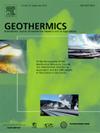The characterization of fractures and analysis of hydraulic properties in granite-type hot dry rock reservoirs
IF 3.5
2区 工程技术
Q3 ENERGY & FUELS
引用次数: 0
Abstract
Hot dry rock (HDR), a widely distributed geothermal resource, holds significant development potential. The geometric characteristics and distribution of the fracture system within the reservoir are crucial, as they directly influence the flow paths and storage capacity of underground fluids. This study establishes a predictive framework for granite-type hot dry rock (HDR) reservoirs in China's Gonghe Basin by integrating field data, stochastic discrete fracture network (DFN) modeling, and geomechanical upscaling. Natural fractures, characterized via imaging logging, cores, and outcrops, exhibit three dominant orientations (NW, NNW, NE) and a power law size distribution. Monte Carlo simulations translated 1D fracture density (P10) into volumetric constraints (P32), enabling 3D DFN construction. Oda-based upscaling revealed permeability anisotropy, with maximum values of 0.268 mD (x-direction), 0.277 mD (y-direction), and 0.135 mD (z-direction), governed by low-dip NE/NW fractures, alongside reduced Young's modulus, Poisson's ratio and localized stress perturbations in fracture-rich zones. Simulated in-situ stresses aligned with field measurements, validating the model. The workflow bridges multi-scale data gaps, offering critical insights for optimizing hydraulic fracturing in low-permeability HDR systems.
花岗岩型干热岩储层裂缝特征及水力特性分析
干热岩是一种分布广泛的地热资源,具有重要的开发潜力。储层内裂缝系统的几何特征和分布是至关重要的,因为它们直接影响地下流体的流动路径和储存能力。通过综合现场数据、随机离散裂缝网络(DFN)建模和地质力学升级,建立了中国和合盆地花岗岩型热干岩(HDR)储层预测框架。通过成像测井、岩心和露头对天然裂缝进行表征,裂缝表现出三个主要方向(NW、NNW、NE)和幂律尺寸分布。蒙特卡罗模拟将1D裂缝密度(P10)转换为体积约束(P32),从而实现3D DFN构建。基于oda的升级显示了渗透率的各向异性,其最大值分别为0.268 mD (x方向)、0.277 mD (y方向)和0.135 mD (z方向),受低倾角NE/NW裂缝的控制,同时在裂缝富集区杨氏模量、泊松比和局部应力扰动也有所降低。模拟的地应力与现场测量结果一致,验证了模型。该工作流程弥补了多尺度数据差距,为优化低渗透HDR系统的水力压裂提供了关键见解。
本文章由计算机程序翻译,如有差异,请以英文原文为准。
求助全文
约1分钟内获得全文
求助全文
来源期刊

Geothermics
工程技术-地球科学综合
CiteScore
7.70
自引率
15.40%
发文量
237
审稿时长
4.5 months
期刊介绍:
Geothermics is an international journal devoted to the research and development of geothermal energy. The International Board of Editors of Geothermics, which comprises specialists in the various aspects of geothermal resources, exploration and development, guarantees the balanced, comprehensive view of scientific and technological developments in this promising energy field.
It promulgates the state of the art and science of geothermal energy, its exploration and exploitation through a regular exchange of information from all parts of the world. The journal publishes articles dealing with the theory, exploration techniques and all aspects of the utilization of geothermal resources. Geothermics serves as the scientific house, or exchange medium, through which the growing community of geothermal specialists can provide and receive information.
 求助内容:
求助内容: 应助结果提醒方式:
应助结果提醒方式:


